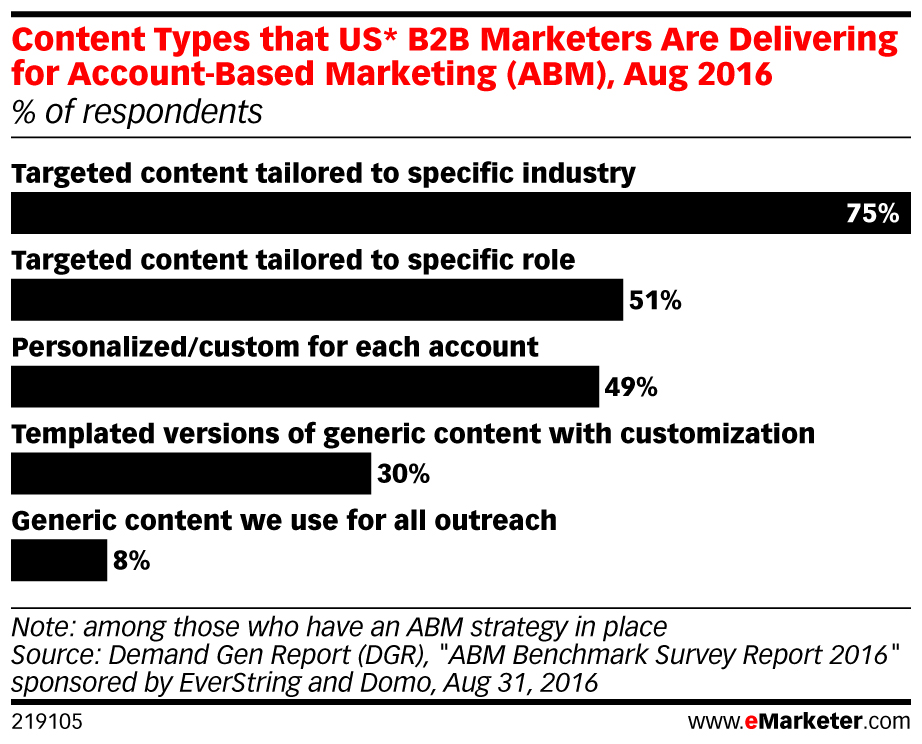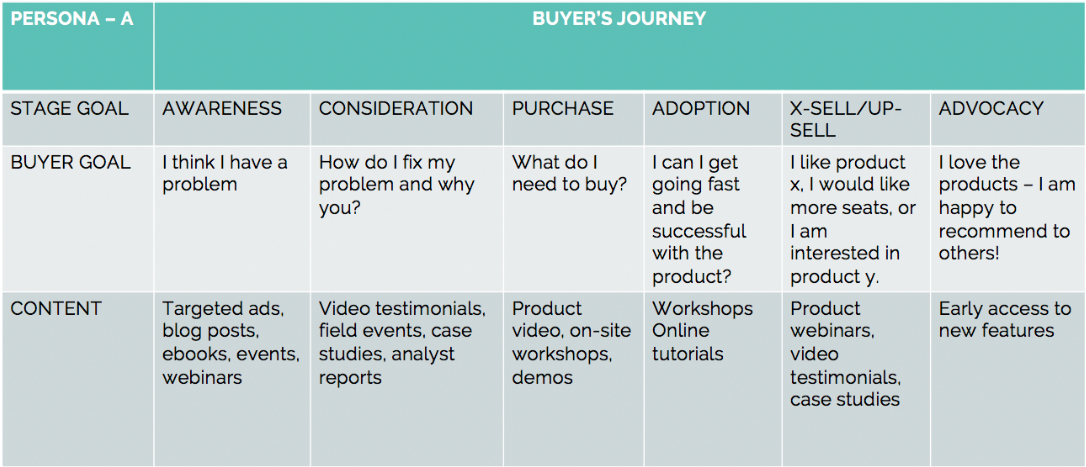Marketers want to invest their time, energy, and resources into strategies that produce measurable results. That’s one of the driving forces behind the rising popularity of account-based marketing (ABM) in B2B markets. According to ITSMA’s 2017 Budget Allocations and Trends Report, 46% of B2B companies increased their ABM budget from the previous year.
ABM is defined by a highly targeted marketing and sales approach that actively targets specific accounts and the stakeholders within them. ABM is a response to long B2B sales cycles, which average more than three months for mid-market companies and can be much longer in enterprise sales. ABM helps companies land higher value accounts with multiple decision makers by fleshing out a complete strategy for marketing to that specific account.
High-value content is most often discussed within the context of inbound marketing, but it can—and should—play a key role in account-based marketing as well. While inbound marketing places the focus on attracting prospects to your company over time, ABM uses content to nurture pre-targeted leads and speak to their biggest concerns throughout the sales process.
In our recent webinar, Everything Content Teams Need to Know About Account-Based Marketing, we dove deeply into how content can be used in tandem with account-based marketing to arm your marketing and sales teams with valuable content that will help them to build solid relationships with accounts and stakeholders.
Creating effective content for your ABM campaigns is all about delivering the right content, to the right prospect, at the right time. Effective ABM content must be personal, timely, and relevant to move the needle and make an impact with the stakeholders of your key account.
Understand the “Who” and “What” of Each Account
In ABM, B2B selling cycles can be complicated. Accounts may have multiple stakeholders who are responsible for providing input before purchasing your product, each with their own needs, concerns, and wishes for the solution their company chooses to invest in. They need to be nurtured and have those concerns addressed to increase your chances of closing the sale and facilitating a smooth sales process.
Timely content sets the stage for your sales reps by facilitating a more well-rounded view of your product and arming them with content that helps them address specific concerns. The collection of stakeholders within each target account is what is known as a “buying center” in ABM terminology.
The fact that the buying center can include as many as a dozen people within some organizations can make content creation for ABM a little more difficult. You can’t create content for an organization as a whole. What might speak to marketing directors won’t have the same impact with sales managers, and worse, may come across as so wholly irrelevant to their interests that it negatively impacts their opinion of your solution.
Effective ABM content requires not only that you identify what types of content each stakeholder is interested in consuming but also where in the buyer’s journey they’ll need to consume it. Content should be delivered to specific personas at specific points in the sales cycle. The top of the funnel is typically filled with broader, more generalized content, but that content should still speak to the specific stakeholder’s concerns and interests as they pertain to your product at that early stage.
To gain deeper insights into key accounts and personas, there are a few channels that you should keep an eye on:
- Annual reports
- Earnings calls
- Social media
- Blogs
Each of these can provide insights into the key issues that each account is facing as they relate to your solution. You can glean information that will help you to personalize your sales and marketing approach to speak to the concerns that they deem most important.
Knowing who each piece of content is for (and when it will be delivered) requires that you have a deep understanding of the different personas that you’ll be marketing to. ABM teams must have personas fleshed out for all of the usual suspects contained within the buying centers of your target accounts.
Audit Your Content to Find Subject Gaps
To start the process of creating content for specific personas within your buying centers, take stock of the content that you currently have at your disposal. You may find that a good percentage of the content you have already published is a good fit—or at least close to a good fit—for the personas you regularly see in account buying centers.
However, not all of the content you have on hand will be useful in ABM, and some may need to be altered, updated, and personalized to speak to key stakeholders. If your content is not personalized for specific roles and organizations, it may be hard for the prospect to connect with it. Repurposing published content in new formats and for new uses can be extremely useful in ABM.
As you audit your content, try to find pieces that are:
- Relevant to your intended audience
- Effective based on analytics
- Easily modified to speak to your target audience
Pieces that meet these criteria will serve as a good foundation for ABM content. While they might need some alterations to be relevant in every situation, a bulk of the work has already been completed on these pieces, and editing them will serve as a better use of your time than creating all of your ABM content from scratch.
Even if you find that you have sufficiently covered a particular subject, you may still need to edit the content to reflect clients within a specific industry. A 2016 survey by eMarketer showed that B2B ABM marketers are prioritizing delivering content that’s tailored to a specific industry, role, or wholly personalized for each account:

The content that you have on hand may not be geared toward a specific industry or role and will require some re-shaping to fit perfectly with your targets. An audit will also help you to find outdated content that needs an update before it’s delivered to prospects. Either way, having a full understanding of the content assets you have on hand is necessary for planning further content production for your targeted personas.
Work With Sales to Identify Key Issues
Sales and marketing alignment is a key component of account-based marketing. The two departments must work together to provide a smooth, seamless experience for prospects and stakeholders. The content you create should have a place in both the marketing and sales processes.
Collaborate with your sales teams to identify key areas of the sales process where they lack assets to assist them. Your sales teams will have a deep understanding of the type of content that they need to have on hand to facilitate positive conversations with prospects. With their input, you can laser-target specific stakeholders and conversations that play a key role in the sales process and arm your sales reps with content that speaks to their prospects’ biggest concerns.
ABM content is there to facilitate the relationship-building process, whether it’s delivered during the marketing or sales process. Great, relevant content will help your sales teams deepen existing relationships and build sturdier connections with stakeholders within organizations.
Plan Content That Brings Buying Teams Together
One of the biggest ABM challenges is putting together content that covers all of the personas within buying centers—which, don’t forget, can swell to twelve or more. That’s a dozen unique personalities who all have their own horse in the race and want to make sure their opinion plays a role in the process for the betterment of their department.
Trying to plan, create, and personalize content for that many different stakeholders is a cumbersome task. It could potentially weigh down your content team’s focus on other projects. Still, your most important stakeholders and personas need that personalized content to envision your solution in their company and develop a deeper connection with your product.
Instead of creating personalized content for every individual, marketers can craft content that helps to align the agendas of the different personas around your solution. The critically acclaimed book, The Challenger Customer, discusses this concept and calls it “convergence” as an alternative to the less-impactful, individual-focused personalization that may fail to drive consensus around your solution.
Speaking to the individual needs of each persona in the buyer’s center while also collectively educating the group as a whole is a delicate balance to strike. Creating content that aligns the needs of multiple personas behind one solution can be an effective way to speak to less-impactful stakeholders without generating full content campaigns.
Map Content to Points in the Buyer’s Journey
One of the key concepts of creating effective content for the buyer’s journey is not just knowing what kind of content to deliver to your buyer centers, but when to deliver it.
In our recent ABM content webinar, we provided attendees with a basic framework for content creation throughout the buyer’s journey. You don’t need to reinvent the wheel here. ABM accounts go through the same basic phases that we think of in a typical cycle:
Finding a place in the buyer’s journey for each piece of content is essential for putting together an ABM content plan. You don’t want to overload an account with content at any point in the journey, but you also want to make sure that you have all of your bases covered. As the sales process moves forward, the type of content you deliver will shift to reflect their current position in the funnel.

As you audit your content, consider what point in the buyer’s journey—and for which personas—the content might be good for. If you can, use a tagging system to organize the content for later.
Remember, just because a piece is delivered in the “Awareness” stage for one persona does not necessarily mean that it’s the right stage for all personas. Different personas in your buyers center have different needs and may require content that covers specific subjects at different points in the process.
Use Analytics To Track Engagement and Measure Effectiveness
Put your faith in your analytics and tracking solutions to help guide the way. By measuring the engagement levels that all different personas have with your content, you can inform your strategies and identify key pieces of content that are really hitting the mark. On the other hand, you can also identify and remove content that is not performing at a high level.
To measure the effectiveness of your content, you need clear goals. For ABM content, the primary objective is increased engagement in target accounts. How are prospects interacting with your content? Are they reading the whole thing or just skimming it? Are they using it to inform future conversations?
Connect your goal to specific metrics and segment your results by persona to see how each piece of content connects with individual audiences.
Once you have your goals in place, make sure that you have the systems in place to measure them. Then, introduce marketing programs that allow you to not just measure the ROI of the content, but measure it at different points throughout the buyer’s journey.
Account-Based Marketing and Content Are Complementary
Content is an absolutely critical tool for account-based marketing.
By taking stock of the standing of your current content and identifying gaps in your subject coverage during an audit, you can begin to lay the foundation of a plan for ABM content that speaks to the biggest needs of your accounts, aligns their interests while painting your product as a solution, and helps to build credibility and stronger relationships with stakeholders.

